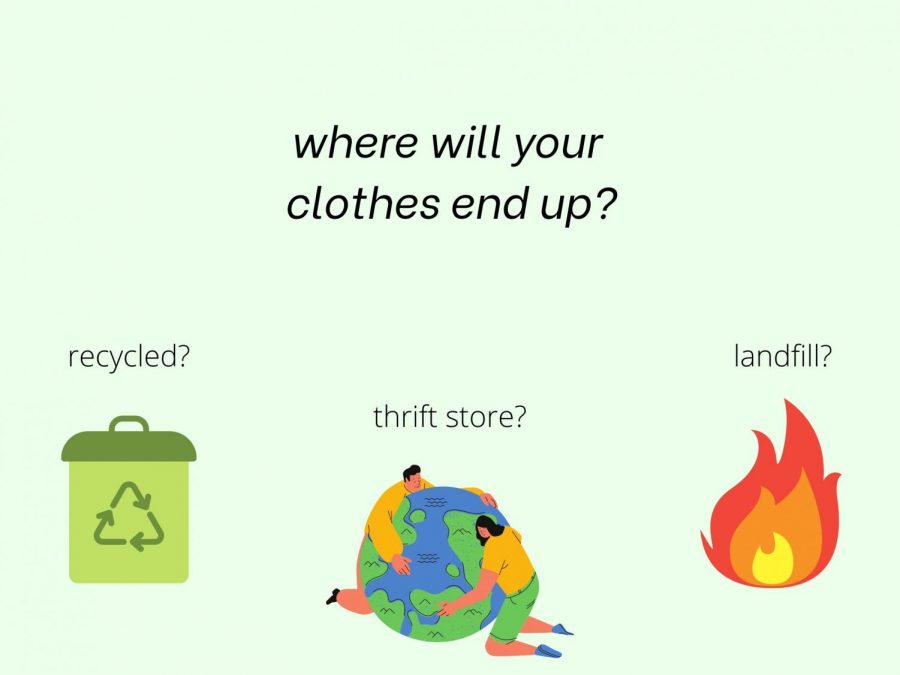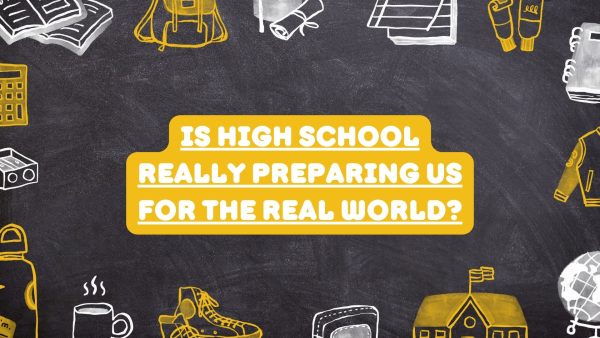Fast Fashion: It’s polluting, unsustainable and exploiting underpaid workers
Malena Fouts-Arteaga created using Canva
Of all clothes that is thrown away globally, only 12% gets recycled, 10% gets sent to a thrift store while the rest goes to a landfill or is burned.
Think about the last time you went on a shopping spree. You go home, try some of it on, and maybe decide that you want to return something. Did you ever think about where it would end up? Of course, most of us don’t stop to think about where it would end up, however, about 85% of clothing thrown away in the U.S. is either dumped into landfills or is burned.
When we get rid of clothing, we usually donate it or just throw it away, and maybe some of us will send it to get recycled. But in reality, only 12% of all clothing that is thrown away globally gets recycled. It seems like such a small fraction, and it really is. Adding on to that, only 10% of clothes that are actually sent to a thrift store are actually sold, which seems like an even smaller percentage. When it isn’t re-sold, it may end up as carpet padding, insulation, or yarn.
Toxic chemicals and hundreds of pounds of decomposing clothes are affecting our environment. The gases are poisoning the air that we need to breathe in and are warming our planet. Chemicals and gases are being released into the air and atmosphere, which isn’t helping with the fact that we already have a bad enough problem with climate change due to pollution. As time goes on, more and more gases are released into our air, which will affect us, the current generation, since we’re still so young. But even when new generations come, the problem won’t go away and may only get worse.
Linh Ngo is a science teacher and environmentalist at Mendez Fundamental. She doesn’t buy from fast fashion and knows what it’s like to be stuck in the unethical practice of fast fashion.
“I am very aware of fast fashion. It is when clothing items are produced large scale and made to be worn very rarely and disposed of very quickly so that you can go and buy more clothes. This practice is highly polluting and unsustainable,” she said.
Sometimes, retailers overestimate the amount of product they should make, clothes specifically. When they make too much and don’t sell all of it, they have to get rid of it, one way or another. Clothes that have not been sold due to overproduction may be burned, depending on the company. One very infamous time a company got caught doing this was in 2017, by none other than H&M. They were accused of burning tons of clothing that were not sold. When hundreds of pounds of clothes are burned at the same time, it releases toxic chemicals into the air, and when more than just one seller or company does this, it becomes a huge problem.
Laura Compton, a teacher at MCHS, does not like buying new. Instead, she buys her clothes from a thrift store or a reselling site called ThredUp.
“Well, the actual recycling of clothes is very difficult, in the sense of making new fabric out of old fabric. Often in the process, the fibers become stiff and difficult to use, thus making for a fabric that isn’t very comfortable to wear,” said Compton.
When you get rid of something that was bought from a fast-fashion brand or company, the article of clothing is most likely made out of cheap materials or multiple fabrics that have been combined. If multiple fabrics have been combined and it cannot be recycled, it just gets thrown away. When this happens, it makes it difficult for us to recycle or resell it.
Not only is fast fashion terrible for our environment, but it’s also unethical as well. When you produce hundreds of pieces of clothing at a time, you need people to make them for you. These workers get paid pennies for a single garment, and not only are they overworked and extremely underpaid, but they are also harassed at work, too. These factories tend to target lower-class workers or third-world countries. However, there are many workers in the fast fashion industry in the US too.
“I think it is unnecessary, unfair, and unethical. It makes me angry to know that this still happens. In fact, my parents used to work for sweatshops like those here in the U.S. when we first moved to California more than 20 years ago. They made pennies off of each item that they sewed while the company made $50 plus per garment. It was backbreaking work, long hours, and very, very little pay. Not to mention the harassment from bosses and lint that they breathed in every day. I used to come home from school to help fold the items or help fix mistakes when I was younger,” Ngo said.
Working in these factories can be very dangerous like Ngo said. Deaths caused by fire incidents and collapsing buildings are frequent. In 2013, there was an incident called the “Collapse of the Rana Plaza,” which happened in Bangladesh. More than 1,100 people were killed and about 2,500 were left injured after the collapse and burning. In another incident, 112 people passed away after being trapped inside the burning Tazreen Fashions factory on the outskirts of Dhaka.
Changing a garment or turning it into something else and finding a new use for it instead of getting rid of it is called upcycling. Let’s say you have a pair of jeans. You still like the way they fit and you don’t necessarily want to get rid of them. Putting patches, adding embroidery, or turning them into something else is considered upcycling. It’s a great way to turn your clothes into something you know you’ll use, such as rags, or a completely new garment.
“What can be done is upcycling. Instead of breaking down the fabric, one can use the same fabric to make different garments or products. You can make handbags out of old jeans or tops out of old dresses for example,” said Compton.
People not only buy from fast fashion because it’s cheap and easily accessible, they buy because their favorite influencers are promoting it. The quick-changing fashion trends of today also influence others to purchase because again, it’s cheap and easily accessible. When people are exposed to new trends, they look for places to purchase their new clothing from. Fast fashion sites and stores keep up with trends and create hundreds of new pieces weekly, giving people a wide variety of new outfits to choose from.
“I think people enjoy how it makes them feel and the novelty of new clothing. There are some who also enjoy copying influencers and those that they find to be popular,” Ngo said.
There’s nothing wrong with taking inspiration from your favorite celebrities or influencers and wanting to look or dress like them. Especially as a young person in these times, there are so many different styles that are being made popular and it’s completely normal to want to follow the latest trends. However, it only starts to become a problem when everyone buys their new clothes from fast fashion. And when people buy hundreds of dollars worth of fast fashion at a time, it becomes an even bigger issue.
Of course, some of us can’t afford to buy from ethical and sustainable sources, but it’s best to try. Sometimes we just don’t have the money to buy nicer things, and that’s okay. When you can, it’s always a great idea to buy something from a small brand or creator that hand makes everything, either by themselves or with a small team. No matter what style you’re into, there are tons of small creators that make and sell clothing and accessories made for your style. Not only are you supporting someone’s lifestyle, you’re buying something that was handmade with care in order to make sure that they can produce the best quality product they can. Buying from a small business also ensures that no one was harassed or underpaid while making your products.
If we were able to get rid of fast fashion entirely, what would happen to the workers is a very important question that needs to be answered. If we got rid of fast fashion and only slow fashion was sold, then many, many people would lose their jobs. These people that work for fast fashion are poor, many living in poverty in third world countries. But where will they go? Will they be left with no job or will they be given a better job, since, without a job, they won’t have any money? It would be nice to get rid of it and make sure that our clothing is made ethically, but we can’t ignore the possible consequences.
Although it’s difficult to change the mindset and lifestyle of such a huge demographic, it’s important that we try to at least educate ourselves and others about the issue and find a solution that’ll work for everyone. This is something that needs careful planning, what if companies refuse to cooperate? Where would poor people buy their clothes since sustainable and ethical clothes can be expensive? This isn’t something that can be fixed quickly. It may take a while, but it’s better than letting this happen.

I love buying clothes for my dog, my favorite band is Lamp, and my favorite animal is the whale shark.





































